电化学法在TiO2纳米管上沉积ZnO制备TiO2/ZnO杂化纳米结构及其应用
IF 6.6
3区 工程技术
Q1 ENGINEERING, CHEMICAL
引用次数: 1
摘要
摘要近年来,TiO2/ZnO杂化纳米结构以其优异的光电化学性能吸引了科学界的兴趣。TiO2/ZnO杂化纳米结构与基于半导体材料的其他光催化剂相比的主要优点在于它们能够形成异质结,其中两种半导体的价带和导带都插在异质结中。该因素导致带隙和复合率的降低以及光吸收范围的增加。本综述的目的是对通过电化学方法在TiO2纳米管上沉积ZnO来合成TiO2/ZnO杂化纳米结构的主要方法进行修订。电化学合成方法提供了一种简单、快速、高效的途径来合成纳米结构,如纳米线、纳米棒、纳米管等。它们使我们能够主要通过控制电压、时间、温度、电解质组成和单体浓度来控制化学计量、厚度和结构。此外,还对TiO2/ZnO杂化纳米结构最有前景的应用进行了研究。在这篇综述中,重点介绍了染料敏化太阳能电池、有机化合物的光电催化降解、光电化学水分解、气体传感器和锂离子电池的应用。本文章由计算机程序翻译,如有差异,请以英文原文为准。
Synthesis and applications of TiO2/ZnO hybrid nanostructures by ZnO deposition on TiO2 nanotubes using electrochemical processes
Abstract In recent years, TiO2/ZnO hybrid nanostructures have been attracting the interest of the scientific community due to their excellent photoelectrochemical properties. The main advantage of TiO2/ZnO hybrid nanostructures over other photocatalysts based on semiconductor materials lies in their ability to form heterojunctions in which the valence and conduction bands of both semiconductors are intercalated. This factor produces a decrease in the band gap and the recombination rate and an increase in the light absorption range. The aim of this review is to perform a revision of the main methods to synthesise TiO2/ZnO hybrid nanostructures by ZnO deposition on TiO2 nanotubes using electrochemical processes. Electrochemical synthesis methods provide an easy, fast, and highly efficient route to carry out the synthesis of nanostructures such as nanowires, nanorods, nanotubes, etc. They allow us to control the stoichiometry, thickness and structure mainly by controlling the voltage, time, temperature, composition of the electrolyte, and concentration of monomers. In addition, a study of the most promising applications for TiO2/ZnO hybrid nanostructures has been carried out. In this review, the applications of dye-sensitised solar cell, photoelectrocatalytic degradation of organic compounds, photoelectrochemical water splitting, gas sensors, and lithium-ion batteries have been highlighted.
求助全文
通过发布文献求助,成功后即可免费获取论文全文。
去求助
来源期刊

Reviews in Chemical Engineering
工程技术-工程:化工
CiteScore
12.30
自引率
0.00%
发文量
37
审稿时长
6 months
期刊介绍:
Reviews in Chemical Engineering publishes authoritative review articles on all aspects of the broad field of chemical engineering and applied chemistry. Its aim is to develop new insights and understanding and to promote interest and research activity in chemical engineering, as well as the application of new developments in these areas. The bimonthly journal publishes peer-reviewed articles by leading chemical engineers, applied scientists and mathematicians. The broad interest today in solutions through chemistry to some of the world’s most challenging problems ensures that Reviews in Chemical Engineering will play a significant role in the growth of the field as a whole.
 求助内容:
求助内容: 应助结果提醒方式:
应助结果提醒方式:


